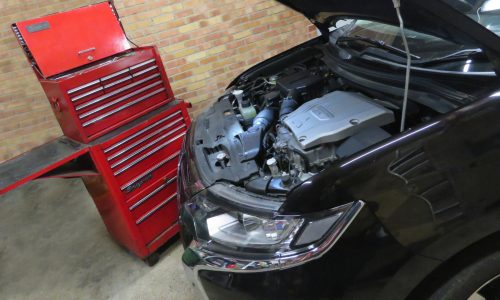Elements of a Vehicle Examination
Motor vehicles and claims are now so sophisticated, it is essential that I travel out to a vehicle examination fully equipped for any eventuality and able to examine every part of a vehicle if necessary.
Therefore, in order to produce an evidentially strong report on a forensic examination of a vehicle it is essential that I have with me a vast array of tools & equipment, the training, expertise, motivation, the time and the professional curiosity to enable me to do so.
Some examples are described below to give a taste of just some of the specialist inspection & testing for which I am equipped.
The really specialised equipment which I use and form a substantial part of a vehicle examination by me are described and demonstrated elsewhere on my website at: Collision Data Retrieval, Laser Four Wheel Alignment & OBD (On-Board Diagnostics) Health Check


A hoist is always preferable to help me get right underneath a vehicle if I find I need to but the location may not accommodate and so I must be prepared to resort to good, old-fashioned jacking and making safe using axle stands before I can venture underneath.
Electrical testing is often another requirement of a vehicle examination which necessitates all sorts of test meters, equipment for heavy discharge and other tests on batteries for cranking power, capacity and also for testing the operation of the charging system.
A lot can be determined from what’s going on inside a cooling system.
Apart from visual checks for leaks etc such equipment is necessary to check for combustion leakage caused by gasket failure, for example, and weak coolant strength can be symptomatic of a faulty cooling system that’s being topped up with just water and so is not offering adequate protection against frost, corrosion and wear.
Once the car is safely jacked up and made safe I am able to remove wheels, dismantle and check brakes for condition, wear and operation. Measurements of brake disc & lining thickness can be recorded, brake drum diameter can be measured and the boiling point of the brake fluid tested and checked against the Manufacturer’s specifications.
This test is essential because of brake fluid’s hygroscopic nature; that is to say it absorbs moisture from the atmosphere through flexible brake pipes, seals and the master cylinder reservoir vent. Too much moisture and complete brake failure can result following periods of heavy braking hence the reason vehicle makers specify brake fluid should be replaced every year or so.
Photography is an essential part of an evidentially strong forensic report but it’s not always possible to get a camera into every place to take photographs.
Therefore I am prepared to carry out what dismantling is required.
Even when extensive dismantling is not proportionate to the claim or may not be possible in the circumstances, though, all is not lost because an examination inside an engine through a spark plug hole or inside a sump plug hole, inside a brake or other assembly can be achieved by the use of an endoscopic camera after some limited dismantling.
This is by no means a comprehensive list of all the equipment I routinely carry around with me or all the elements which make up every vehicle examination I undertake which will largely depend on the reason for that examination.
I may need to concentrate on different parts of a vehicle in an investigation into a staged accident, an exaggerated or invented claim for crash damage than, say, for a sting operation I may undertake for Trading Standards Officers in preparation of a prosecution of a motor trader which will differ from investigations I may carry out for the consumer press and that will differ again from the sort of examination I may have to undertake to investigate vehicle or component failure to name but just a few reasons I may be engaged for a specialist examination of a vehicle.
